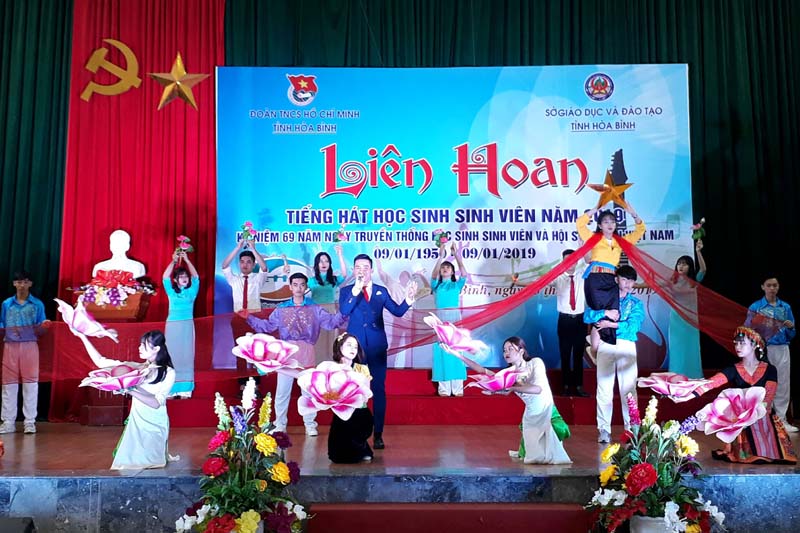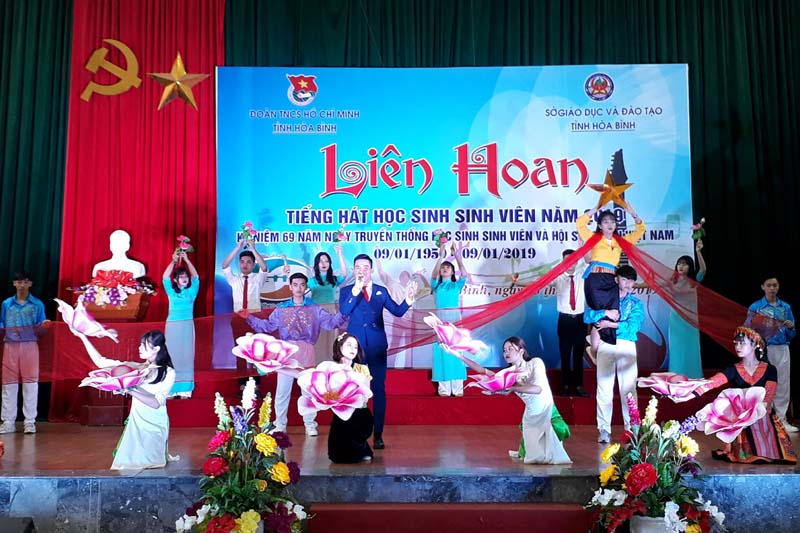
(HBO) – The provincial Ho Chi Minh Communist Youth Union and Department of Education and Training of Hoa Binh have co-organised the 2019 Hoa Binh Student Singing Festival. The event gathered more than 500 students and teachers from 35 boarding secondary schools, high schools and colleges across the province.

The performance of the song"Nguoi la niem
tin tat thang” (Ho Chi Minh the belief for sure victory) by Tan Lac
High School wins the first prize at the solo category of the festival.
Participating teamsstaged 50 songs, which were
classified intosolo
and group categories.The songs focused on the
themes of praising the Party, the late President Ho Chi Minh and patriotism.
The festival was a practical activity to
celebrate the 69th anniversary ofVietnameseStudents’Traditional Day (January 9, 1950 – 2019). It helped to promote cultural and musical activities at schools; as well as create a playground forlocal studentsto get together andexchange experiences concerningthe organisation of youth activities.
The festival awarded four first, eight second, 12 third and 14
consolation prizes. The first
prizes of the single category belonged to Tan Lac High School with the song"Nguoi
la niem tin tat thang” (Ho
Chi Minh the belieffor surevictory) and the Hoa
Binh Continuing Education Center with "Hanh phuc xuan ngoi” (Spring happiness).
Meanwhile, in the group category, the first prizes went to the Cong Nghiep High
School with "Xinh tuoi Viet Nam” (Charming Vietnam) and Tan Lac High Shool with
"Xuong cho mua que” (Going to countryside market).
At the event, the organisers granted the provincial certificates of merit to honour five groups and 23 individuals./.
With an increasingly vibrant and widespread emulation movement aimed at building cultured residential areas and cultured families, Yen Thuy District has been making steady progress toward improving both the material and spiritual well-being of its people, while fostering a civilized, prosperous, beautiful, and progressive community.
Once lacking recreational spaces and community facilities, Residential Group 2 in Quynh Lam Ward (Hoa Binh City) has recently received attention for the construction of a new, spacious, and fully equipped cultural house. The project followed the model of state support combined with public contributions in both labor and funding.
The "All people unite to build cultural life" movement, which has been effectively integrated with Kim Boi district’s socio-economic development goals, is fostering a lively spirit of emulation across local residential areas, hamlets, villages, public agencies, and enterprises. In addition, through the initiative, traditional cultural values are being preserved and promoted, while community solidarity and mutual support in poverty reduction and economic development are being strengthened.
A working delegation of the Hoa Binh provincial People’s Committee led by its Permanent Vice Chairman Nguyen Van Toan on June 11 inspected the progress of a project to build the Mo Muong Cultural Heritage Conservation Space linked to tourism services in Hop Phong commune, Cao Phong district.
Born and growing in the heroic land of Muong Dong, Dinh Thi Kieu Dung, a resident in Bo town of Kim Boi district, in her childhood was nurtured by the sweet lullabies of her grandmother and mother. These melodies deeply imprinted on her soul, becoming an inseparable part of her love for her ethnic group's culture. For over 20 years, this love for her hometown has driven Dung to research, collect, and pass down the cultural values of the Muong people to future generations.
In the final days of May, the Ethnic Art Troupe of Hoa Binh Province organized performances to serve the people in remote, mountainous, and particularly disadvantaged areas within the province. These were not just ordinary artistic shows, but they were the meaningful journeys aimed at spreading cultural values, enhancing the spiritual life of the people and contributing to the preservation of ethnic minority cultural identities.



